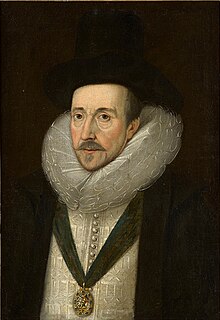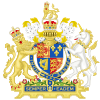Henry Howard, 1st Earl of Northampton
KG | |
|---|---|
 Henry Howard, Lord Warden of the Cinque Ports, since 1 January 1604 and Earl of Northampton since 13 March 1604 | |
| First Lord of the Treasury | |
| In office 1612–1613 | |
| Preceded by | The Earl of Salisbury |
| Succeeded by | The Viscount Brackley |
| Lord Privy Seal | |
| In office 1612–1613 | |
| Preceded by | The Earl of Salisbury |
| Succeeded by | The Earl of Somerset |
| Personal details | |
| Born | 25 February 1540 Frances de Vere |
| Religion | Roman Catholicism |

Henry Howard, 1st Earl of Northampton
Early life
Howard was born at
Howard's father, the Earl of Surrey, a Catholic but with reformist leanings, was heir to the 3rd Duke, and thereby destined to become the future 4th Duke; but that changed at the end of 1546 when Surrey
Surrey initially entrusted the education of his children to the Dutch physician and classical scholar
Subsequently both Henry and his older brother Thomas studied with
Under suspicion
He protested in 1568 to
After his brother's execution in June 1572, Howard retired to
In favour under James I

He attached himself both to
Howard helped his great-nephew, Thomas Howard, Lord Maltravers to regain royal favour following the Scottish monarch's accession to the English throne as James I. Maltravers and his mother, the widowed Countess of Arundel had suffered economic and political difficulties in the 1580s and 1590s due to their Catholicism [15] and the attainder of the 13th Earl in 1589 following his conviction for treason, which led to forfeiture of his title and property. In 1604, Thomas was able to regain the Earldom of Arundel and estates.
In 1603 he was made a
In 1604 he was one of the commissioners who composed the peace treaty with Spain. Howard organised the welcome of the Spanish ambassador, Juan Fernández de Velasco y Tovar, 5th Duke of Frías, Constable of Castile, who came to sign the treaty in August. The Constable was brought up the Thames in a boat, admiring the sights, including Anne of Denmark and her companions who attended in a barge near the Tower of London wearing black masks. Howard received a pension of £1000 from the Spanish Court.[16]
In 1604, Howard called the playwright
The Overbury case

He assisted his great-niece,
Last days

Months before his death, Howard ordered his father's remains moved from the
He advised against the summoning of Parliament in 1614,[20] and then fomented disputes to compel James to dissolve it. He died unmarried on 15 June 1614 and was buried in the chapel of Dover Castle; the monument erected above his grave was subsequently removed to the chapel at Trinity Hospital, Greenwich. His title became extinct at his death. His will, in phrasing that has been considered equivocal, can be reasonably interpreted to imply that he died a Roman Catholic.[1][4]
Works
He was the author of:
- A Treatise of Natural and Moral Philosophy (1569; manuscript in the Bodleian Library)
- A pamphlet supporting the union between Elizabeth and the duke of Anjou(1580; Harleian MSS. 180)
- A Defensative against the Poyson of supposed Prophecies (1583)
- A reply to a pamphlet denouncing female government (1589; Harleian Manuscript 7021)
- Duello Foiled, printed in Thomas Hearne's Collection of Curious Discourses (1775), ii.225, and ascribed there to Sir Edward Coke
- Translation of Charles V's Last Advice to Philip II, dedicated with a long epistle to the queen (Harl. 836, 1506 and elsewhere in Stowe 95, Kings Manuscripts 106)
- Devotional writings (Arundel Manuscripts 300)
- Speeches at the trials of Guy Fawkes and Garnet in State Trials, vol. I.
- In Somers' Tracts (ed. 1809), ii.136, his opinions on the union between England and Scotland are recorded.[1][4]
Building
He enlarged
During the funeral of Anne of Denmark in May 1619, a large stone letter 'S' fell from the battlements of the frontispiece of Northampton House on the procession, killing one William Appleyard. According to Nathaniel Brent, the stone was "thrust down by a gentlewoman who put her foot against it, not thinking it had been so brickle [brittle]".[24]
Family Tree
| 16. Maud Herbert, Countess of Northumberland | |||||||||||||||||||
| 1. Henry Howard, Earl of Northampton | |||||||||||||||||||
| 24. Robert de Vere | |||||||||||||||||||
| 12. John de Vere | |||||||||||||||||||
| 25. Joan Courtenay | |||||||||||||||||||
| 6. John de Vere, 15th Earl of Oxford | |||||||||||||||||||
| 13. Alice Kirlington | |||||||||||||||||||
| 3. Frances de Vere | |||||||||||||||||||
| 14. Edward Trussell | |||||||||||||||||||
| 7. Elizabeth Trussell | |||||||||||||||||||
| 15. Margaret Dun | |||||||||||||||||||
References
- George Frederick Nott (1815), life in Surrey's and Wyatt's Poems
- Anne Somerset (1997), Unnatural Murder: Poison at the Court of James I
- Alan Stewart (2004), The Cradle King: A Life of James VI and I
Notes
- ^ a b c d e f g h i Chisholm 1911.
- ^ The Heraldic Charge Against the Earl of Surrey, Peter R. Moore, English Historical Review, Volume CXVI, pages 557 to 583, (2001).
- ISBN 9780199550371
- ^ a b c d e f g h i j . Dictionary of National Biography. London: Smith, Elder & Co. 1885–1900.
- ^ doi:10.1093/ref:odnb/13941. (Subscription or UK public library membershiprequired.)
- ^ Adams, H.G. A cyclopedia of female biography.
- ^ "Journal of the House of Commons: April 1559 Pages 53-55 The Journals of All the Parliaments During the Reign of Queen Elizabeth". British History Online. Retrieved 8 October 2021.
- ^ "Howard, Henry (HWRT564H)". A Cambridge Alumni Database. University of Cambridge.
- ^ tudorplace.com.ar
- ^ Somerset, p. 19.
- ^ npg.si.edu
- ^ Stewart, p. 164.
- ^ HMC 5th Report: Griffith (London, 1876), p. 408.
- ^ Stewart, p. 224.
- ^ Chisholm 1911, p. 708.
- ^ Linda Levy Peck, Northampton: Patronage and Policy at Court of James I (London, 1982), 110: Calendar State Papers Domestic, 1603–1610, 141.
- ^ C. H. Herford and P. Simpson, eds. Ben Jonson vol. 1 page 141; See also Philip J. Ayres, "Jonson, Northampton, and the 'Treason' of Sejanus." Modern Philology 1983
- ^ . Dictionary of National Biography. London: Smith, Elder & Co. 1885–1900.
- ^ Historical Manuscript Commission: Report on the Manuscripts of the Earl of Mar and Kellie (London, 1904), p. 58.
- ^ Stewart, p. 251.
- ^ british-history.ac.uk
- ^ geograph.org.uk
- ^ mercers.co.uk Archived 12 June 2011 at the Wayback Machine
- ^ Norman MacClure, Letters of John Chamberlain, vol. 2 (Philadelphia, 1932), p. 237: CSP. Domestic, 1619-1623, p. 45.
- Attribution
- This article incorporates text from a publication now in the public domain: Chisholm, Hugh, ed. (1911). "Northampton, Earls and Marquesses of". Encyclopædia Britannica. Vol. 19 (11th ed.). Cambridge University Press. p. 766.
 This article incorporates text from a publication now in the public domain: "Howard, Henry, Earl of Northampton". Dictionary of National Biography. London: Smith, Elder & Co. 1885–1900.
This article incorporates text from a publication now in the public domain: "Howard, Henry, Earl of Northampton". Dictionary of National Biography. London: Smith, Elder & Co. 1885–1900.
External links
- Lord Henry Howard (1540-1614): an Elizabethan Life, by D.C. Andersson, D. S. Brewer, Woodbridge, Suffolk, 2009
- Mercer Connections (PDF)[permanent dead link]





